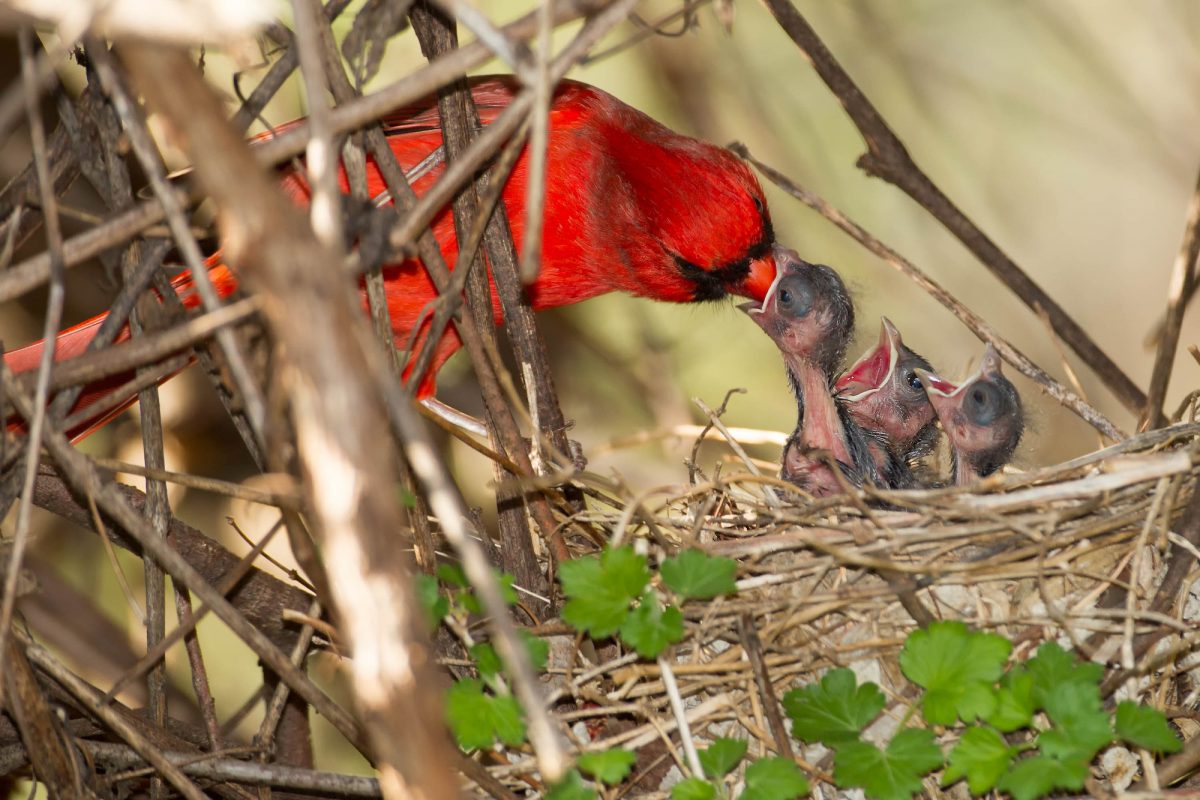The Northern Cardinal, or “Cardinalis cardinalis,” is a well-known species of songbird found in the United States and parts of Canada.
Although they often look like they are simply going about their daily business– snacking on seed, flitting from branch to branch– understanding the life cycle of this species can offer valuable insight into its behavior and environment. We took a closer look at the details of these beautiful birds, including how long you can expect them to live in the wild and when kept in captivity.
What Are Cardinals?
Cardinals are medium-sized songbirds that belong to the family Cardinalidae. They have a distinctive red plumage, with males having a bright red crest and black face mask.


Females are usually more muted in color, with grayish-brown feathers and reddish highlights.


Cardinals are found in wooded areas throughout the United States and parts of Canada, where they feed on seeds, fruits, and insects.
How long do Cardinals live?
In the wild, cardinals typically live for about 3–5 years. However, some have been known to live up to 15 years in captivity. The oldest recorded cardinal was a female that lived to be 15 years and 5 months old!
In general, cardinals that are kept in captivity tend to live longer than those in the wild due to the protection from predators and access to food and water.
Cardinals are also known to be quite hardy birds and can survive in a variety of climates. They can adapt to colder temperatures by growing thicker feathers and huddling together for warmth. This helps them survive the winter months when food is scarce.
Factors that impact lifespan
There are a number of elements that can have an impact on the expected lifespan of cardinals, and these include:
Diet
Cardinals need a balanced diet of seeds, fruits, and insects to stay healthy. A lack of nutrients can lead to poor health and a shorter lifespan.
Predators
Cardinals are vulnerable to predators such as hawks, owls, cats, and snakes. If they are able to avoid these predators, they will have a better chance of living longer.
In built-up areas, these birds may also be vulnerable to window strikes and other human-related hazards, which can dramatically reduce their expected lifespan compared to a bird in more rural and remote locations.


Weather
Extreme weather conditions can be dangerous for cardinals, as they are unable to regulate their body temperature. Cold temperatures can lead to frostbite and other health issues, while hot weather can cause dehydration.
Habitat
Cardinals need a safe and secure habitat in order to thrive. If their habitat is disturbed or destroyed, they may not be able to find food or shelter, which can lead to a shorter lifespan.


The Cardinal Life Cycle
Cardinals have a life cycle that is pretty similar to other birds of this type, and we took a closer look at this below:
Courtship
Cardinals begin their courtship in the spring, to coincide with a high availability of insects to enjoy, and males will often sing to attract a mate.
Once a female has been chosen, they will build a nest made of twigs, leaves, and bark together in a process that takes around 3–9 days in total.
After the nest is in place, the female will then lay eggs once this is complete. Cardinals are one of the birds that mate for life, so the partner they choose now will likely remain by their side until death.
Egg laying
Cardinals lay a clutch of 3–4 eggs, which are incubated for 12–13 days before hatching. Eggs may be incubated by either parent, and the male and female birds will often take it in turns, with the male feeding his mate regularly. Once the eggs are fully incubated, they will begin to hatch, and the baby chicks will emerge.
Hatchlings
The hatchlings are born blind and helpless and will need to be fed by their parents for the first few weeks of their life. The parents will take it in turns feeding them three to four times each day, and the chicks will grow quickly.
After around two weeks, they will begin to explore outside the nest, although they will still rely on their parents for food for a few more weeks.
Fledglings
Once the chicks are around five weeks old, they will be ready to leave the nest and become independent. They will still rely on their parents for food for a few more weeks, but they will now be able to fly and find food for themselves.


Adulthood
Cardinals reach adulthood at around 10–12 weeks of age, and they can now live independently. They will form their own territories and find their own food, and they will also begin to breed.
What do Cardinals eat?
Adult cardinals will feed on a variety of foods, including seeds, fruits, insects, and even small reptiles. They are also known to eat suet and other birdseed mixes from bird feeders. Some key elements of their diets include:
Seeds
Seeds form a key element of the diet of cardinals. They will feed on a variety of seeds, including sunflower, millet, and safflower.
Fruits
Cardinals also enjoy eating fruits such as cherries, blueberries, and grapes. They are also known to eat apples, oranges, and other citrus fruits.
Insects
Cardinals will also feed on insects such as caterpillars, grasshoppers, and beetles. They are also known to eat spiders, snails, and other small invertebrates. This fairly varied diet allows cardinals to thrive in the wild, and they can find food in a variety of habitats.
Cardinals are also known to visit backyard bird baths for a quick drink or bath or opt for a dip in a nearby pond or lake to cool off and refresh.


Final Thoughts
Cardinals are beautiful and popular birds, and they can live and thrive for several in the wild. They are monogamous birds, so they will often stay with the same partner for life.
Cardinals also have a varied diet, which also helps them to thrive in the wild, as they can usually find food in a variety of habitats.
Source link

